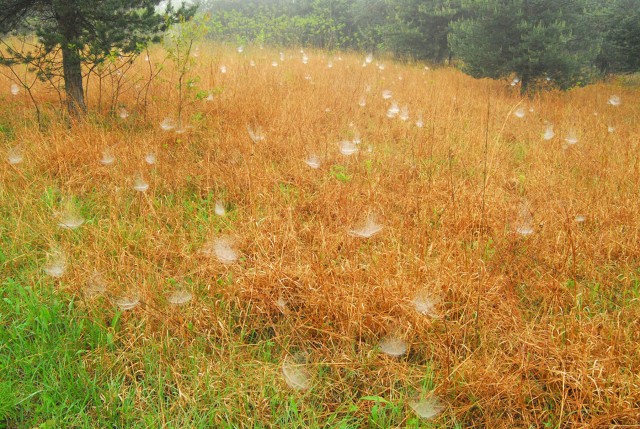
This is part 1 of The Roots of Photography e-book, based on the book The Photographer’s Eye (paid link) by John Szarkowski. It is about what makes photography unique in the art world.
The Thing Itself: A Tool for Cultivating Wonder
“The world itself is an artist of incomparable inventiveness, and to recognize its best works and moments, to anticipate them, to clarify them and make them permanent, requires intelligence, both acute and supple.” ~ The Photographer’s Eye, John Szarkowski
The camera itself is a mechanical tool. When we have our cameras with us, we have subconsciously made the intention to be more aware of the world around us. And that world to me is filled with wonder. Part 1 of The Roots of Photography shows how the camera can be used to experience wonder on a daily basis.
The image above shows an example of wonder for me. My husband and I were staying in a rustic cabin in Brown County, Indiana. We awoke to a light fog and the ground was covered with these cobwebs – it was totally unexpected and a magical experience! By late morning, the fog had lifted and the cobwebs were no longer there, or at least no longer visible. Luckily, I was able to capture it with my camera before it disappeared from view.
Most of us use our cameras to bring attention to what has meaning for us. When we see something that makes us stop in wonder (a flash of perception), we want to present the image so that it reflects what stopped us.
Reflection
Do you see the world as an “artists of incomparable inventiveness?” If not, why?
Is the camera a tool for cultivating or capturing wonder for you?
When was the last time you experienced wonder? Did you capture it with your camera?
What other practices cultivate wonder in your life? How can you be more aware of the wonder around you?
Exercises
Here are 5 ways that photography can cultivate wonder.
1. Spend a day noticing light – its quality (bright, harsh, soft, diffused); its direction (side, back, front, above, indirect); its color (warm, cold). Notice how it’s always changing.
2. Take a photo walk. Focus on two senses, for example, the sounds you hear and the feel of your feet hitting the ground. This will help quiet your mind. What attracts your attention when your mind isn’t chattering away?
3. Spend time with a child. Children are full of wonder. Notice how they approach the world. Photograph them. Then, give them the camera. What do they photograph?
4. Pick one subject from nature and photograph it in detail. Wonder can be found in the details. See its curves, its color, its flaws, and its beauty. Has your wonder for this subject increased? In what way? When we spend time with someone or something and really see it, we cultivate wonder.
5. Explore the work of other photographers who have a wonder-filled sensibility. Like MAV and SCB from Maine and Vermont, who blog at 3191 Miles Apart, or Andre Gallant, or Susannah Conway.
Additional Resources
Tracking Wonder, a blog (and a book) by Jeffrey Davis
Yes, my camera is definitely a tool of wonder.